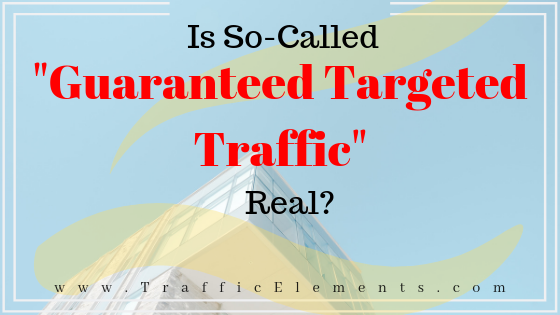
You’ve obviously come to this page hoping to find a positive answer to the question “is guaranteed targeted traffic real”? I’m going to give you enough information in this post to help you make an informed decision as to whether or not spending your money on such a thing is wise.
Before we get into the nitty-gritty of buying website traffic, we need to qualify just what we’re talking about here.
There are vast differences between the terms “paid traffic”, “bulk traffic”, “targeted traffic” and finally “guaranteed targeted traffic”. Because it's that last phrase that brought you to this page, we’ll focus on that, but we will touch upon the other terms because they’re also relevant.
And although the landscape for the “guaranteed targeted traffic” scene is admittedly fraught with pitfalls and scams, it’s not all doom and gloom (but don’t skip to the end!) There are some bright spots to be had, but they’re few and far between, and they also come with one major caveat.
Do You Want to Be a Marketer, Or Do You Just Want the Traffic?
This is an important question here at the beginning. Because when we’re talking about terms such as “targeted traffic” and then “guaranteed targeted traffic” we need to understand that these ideas mean very different things, depending on what your intention is.
For example, if I were a Social Media company, I would be looking to employ the different types of social media to build my brand or sell my products. It wouldn’t make a whole lot of sense to try and buy traffic from a traffic reseller, when the same budget will get me ultra-targeted visitors on a social media platform such as Facebook.
So it’s important to differentiate between marketing and buying traffic.
Marketing takes a lot of time, expertise, and effort. You’ll need to employ such tactics as keyword research, search engine optimization, content marketing and proactive promotion.
Paid traffic is a different ball of wax altogether. Here you’ll be involved in pay-per-click, facebook ads, solo ads and media buys.
And just because you pay money to start driving traffic to your offers does not mean that you will be successful. Pay-per-click, - whether through Google AdWords, Facebook Ads or Bing Ads - is a great place to lose your shirt due to high competition, poor testing, and expensive clicks.

Pay-per-click marketing is a great way to test your offers, but do your homework!
You can also buy solo ads from ezines, which is a popular way of driving targeted traffic to your site these days - but don’t expect this to be a cash-cow unless you’ve also done your own research, split-tested your offers to death, and still have money to burn to account for highly fluctuating click-through rates.
Now, here is where many people get utterly discouraged. They may not want to become full-blown “internet marketers” because they don’t have the time or the expertise. And they don’t have the budget to burn though $5,000 or $10,000 on ad campaigns that most likely won’t even break even.
It’s often at this point that people think - there’s got to be an easier way to get traffic to my site. And so they begin to hit the search engines looking for a quicker way of getting the results they desire.
Enter the paid traffic services.
They line up like circus ringmasters - each one pitching you on why their paid traffic scheme is the best for all your traffic needs.
“No, no - this isn’t fake traffic at all, sir. No we don’t use ‘bots’ or autosurf traffic. This is all very qualified and above-board. Have a peek at my sharp looking website. Look at these authentic testimonials. And, for only $20, we’ll send 20,000 honest-to-goodness ready-to-buy visitors to your website… Your credit card number is…?”
They used to be called snake-oil salesmen. But nowadays they’re called “traffic sellers.”
Whether it’s a “no-bot” traffic gig from Fiverr, “guaranteed youtube views”, or some other such nonsense, you need to hold on tightly to your wallet while you peruse their websites. These charlatans are highly skilled at faking authority, faking testimonials… and faking traffic.
Is It Fake Traffic, or Just Low-Quality?
Sometimes the difference between the two is indistinguishable. But to be fair, there are traffic sellers who do indeed provide real traffic, but the way they provide the traffic almost completely nullifies all of their own targeting filters. We’ll get to that in a moment.
First, we need to know what fake traffic is, and how to spot it.
Fake website traffic is exactly what it sounds like. There are no actual people viewing your site, but somehow or other you get charged for having a visitor.
Adbots
An adbot is malware software that is secretly installed on someone’s computer. This might be through a download, a virus, or by visiting some spurius website and having a bot installed on through your computer’s web browser.
The adbot creates a “virtual browser” on your computer that then silently and invisibly visits websites, scrolls through their pages, and even clicks links. All without the user ever knowing!
No one actually is viewing the ads, it’s just a computer program scrolling and clicking away.
When there are hundreds or thousands of these adbots installed on computers all over the world, this is what is known as a “bot-net.” Bot-nets can generate thousands of page views, and mimic real website visitors very quickly.
Of course, no one in the world would ever claim to use a traffic bot (except for one, which I’ll share later), but there are certainly tell-tale signs that you’ll want to be able to spot.
Here are four different ways to identify fake traffic.

Fake traffic simply takes your money and pretends to give you traffic in return.
Low session duration - when you look at your website’s statistics, you’ll find all kinds of interesting analytics that are helpful in identifying who your traffic is, where they are coming from, what they are doing, and how long they are staying. Session duration is one such analytic that tells you how long someone is staying on your page. If you’ve paid for traffic and your web analytics shows you that the average time on page is very low, then you’ve probably got fake bot traffic.
High bounce rate - this is a metric that guages what percentage of visitors quickly leave your site (i.e. “bounce”) after looking at just one page. This is often seen in traffic bots and “jingling” traffic. This could also mean that your visitor doesn’t like your page, doesn’t feel compelled to stay, or just can’t find what they’re looking for. So it doesn’t necessarily mean “bot traffic”, but it is something to look for.
Low pages per session - when your analytics shows a very low number of pages visited per session, that could also be an indicator of bot traffic. As with the “high bounce rate” metric, it could also mean your website needs work.
Multiple page views - This is also called “new sessions” and indicates multiple screen or page views. When this number is high, it usually means a bot is “refreshing” your page a lot, or could mean that your site is being viewed over and over again by the same visitor - which would indicate the use of an autosurf program (more on that later).
You might be thinking, hey that’s great if I’ve already been scammed, but how can I prevent this from happening in the first place? I can’t afford to pay for fake traffic over and over again!
Good point.
Like all things scam-related, these people often leave clues as to their intentions right on their own websites. You can identify them by their common traits:
Bad spellers. In other words, there are grammatical errors on the website. This shows that the website is not professional, not to be trusted, and almost certainly uses fake traffic.
Weird domain names. If the traffic site name is just a bunch of unrelated, mixed around keywords, stay clear. Names like webtrafficgo.com or buywebfasthere.com. These are clearly scams to avoid.
Missing business address. If you can’t find a proper business address on it’s own page or in the contact page, this is a clear sign that the webmaster does not care to be found.
“We can do it all!” Otherwise known as one-stop-shopping, if the site you are considering also provides youtube views, facebook likes, search engine optimization they are more than likely using different bots to provide traffic. Why? Because real traffic sellers specialize. It costs money to do things right. If a traffic seller claims to do it all, it’s because it isn’t costing them a thing to do it right; therefore, they must be using bots.
Spurious Traffic Sellers: Here are six examples of questionable website traffic sellers.
- Alexamaster.net
- Traffic-Masters.net
- BuyBulkWebTraffic.com
- BabylonTraffic.com
- WebsiteBooster.net
- KingTraffic.net
Note how each of these sites claims to sell only 100% guaranteed real human traffic, with no bots, etc. (except for BabylonTraffic, who are clearly selling to a different audience who are not at all concerned about using bot traffic, lol)
Ok, so before we talk about the good news, we need to address the issue of low quality traffic.
Low quality traffic is low because of the methods that were used to deliver it. Keep in mind that this kind of traffic might actually be “targeted traffic.”
What?
How is that possible? To answer that, we need to look at the traffic delivery methods that traffic sellers use.
Pop-ups and pop-unders: There’s a reason why the Chrome Store is packed with popup blockers… popups are annoying. Whether you personally believe that or not, there are certainly a vast majority of people on the web who seem to think so. Pop-up traffic is generally seen as an intrusion to an otherwise good user experience. If a traffic seller focuses on on popups to deliver traffic to your site, it will be certainly be real (maybe even “targeted”) albeit low quality.
Interstitial ads: These are another kind of annoying ad that you will most likely seen in free games and apps which you’ve downloaded on your iPad or smartphone. Some traffic sellers will use an interstitial ad to serve traffic, and you can be your “visitors” will just as annoyed to see your site as they are when they’re forced to see an ad while playing “Candy Crush”.
Iframe traffic: These are used to display your ad or full website and are exactly what they sound like. Website traffic, often from expired domains, is redirected to a site which displays one or several iframes on a page.
This is perhaps the “best of the bunch” since this traffic is often very closely related to your niche, and may actually result in some positive action on the part of a visitor. It’s just as likely that they’ll click their back button however, when they discover that the website they’re actually looking for is not there.
Rotator traffic: Although a traffic rotator almost always uses real traffic, this traffic is extremely unresponsive, for various reasons. Often this kind of traffic is incentivized, meaning they have ulterior motives for viewing your site.
A typical traffic exchange, whether manual or auto surf, if filled with people who have no other reason to view your site, other than to gain “credits.” This might be a site such as EasyHits4U (a manual traffic exchange), Hitleap (an autosurf traffic exchange), or Rotate4All (a paid-to-promote rotator). Either way, the response of these types of traffic will be quite low. If your patient with them, and you have the time, you can actually seen some pretty good returns on traffic exchanges however.
Traffic sites such as GotHits.org, SurferDudeHits.com, and Traffic365.net use traffic rotators to serve traffic, and you will not see much response from such traffic, regardless of how cheap this traffic is.
As you can imagine, all of these traffic sellers offer “geo-targeting” and traffic targeting according to category (business, hobbies, gardening, etc) or broad niche. This sounds perfect, and normally it would be… except for the fact that the traffic delivery methods most often annoy the crap out of visitors, regardless of whether or not they’re in the same category or not.
A Few Good Men… Er, Sites
At last we get to the part that you’ve been waiting for. There are, in fact some traffic sellers that really do try to deliver good, honest traffic at affordable prices.
These sellers are not scammers, not using questionable traffic tactics, and are trying to provide a traffic service that falls somewhere in between the do it yourself marketers, and the high rolling advertising buyers of the industry.

Traffic resellers are generally legitimate traffic resellers concerned about quality traffic.
Although some of them do use low quality traffic generation, they may also use better methods to serve traffic. When you can use, for instance, expired domain traffic or iframe traffic you should - since those methods have the best chance of some sort of action being taken. Avoid using pop-ups, pop-unders, rotator or interstitial ads. These are very low quality traffic methods, and your ROI from them will be either zero or next to zero.
- Revisitors.com - This seller apparently has a large network of sites from which they drive traffic. Some of their sites are “large portals”, and others are “narrow market” niche sites. This information comes right from their main webpage, and I realize that nearly all traffic sellers say the same thing. However, I believe these guys are legit and really do own a network of sites. They do use pop-ups and interstitial ads, so their traffic quality is low.
- MaxVisits.com - They also apparently have a large network of websites and domain names that they pull traffic from. Their traffic delivery method includes the use of iframe traffic and iframes, so they tend to have a better chance of conversion.
- VisitorMaker.com - The bulk of their traffic appears to come from expired domains, so these might be a good choice. Their price point also appears to be the cheapest, and that is actually a red flag. When in doubt, remember, if your traffic is costing less than a penny per visitor, you are wading ever so deeper into “fake visitor” territory.
- WebTrafficGeeks.org - These are the most expensive of the bunch, and their method of traffic delivery is based largely on expired domain traffic. Although that’s as much as they willing to reveal, the good news is that, of all the traffic sellers I researched, they were the only one that conducted tests to find out their own bounce rate, time on site, and average pageviews per visitor. So it seems they take their traffic very seriously.
Although there are many other traffic suppliers out there, these were the only ones I could find that seemed to take their traffic generation seriously, and did not seem to be only interested in making a quick buck.
Is This Kind of Guaranteed Targeted Traffic Good For Anything?
Absolutely!
But don’t expect it to make thousands of dollars in sales for you after one session.
You can make money from this kind of traffic, but only if you go about it in a very specific way. That specific way is this: the page you promote must be focused on a singular action. What this means is that your best bet is to promote a high-quality squeeze page.
As long as your squeeze page is clean and straightforward, has high quality graphics, and a clear call to action, you will probably see fairly decent returns. You may not see anything like a 3% Click Thru Rate, but you can certainly see a 1.5% to 2% return.
Again, the onus is on you to either create, pay for, or otherwise acquire a high converting squeeze page to use for this traffic.
Apart from this kind of in your face call to action, can you do anything else useful with this traffic? Sure, you can also:
- Drive up the value on your domain.
- Increase your brand’s exposure.
- Increase your Google Analytics metrics for your site, such as bounce rate or time on site.
- Increase the adspace value for your site.
And there you have it. Everything you need to know about buying traffic for you site. You now know what to look for, what to avoid, and how to effectively use the traffic that is sent to your site. Although this is not nearly as risky as other traffic generation techniques such as pay-per-click, you still need to be careful to have a very specific purpose set up, and you’ll still need to do extensive testing with your traffic to know what is working and what is not.
Posted from my blog with SteemPress : https://trafficelements.com/2019/09/04/is-so-called-guaranteed-targeted-traffic-real/